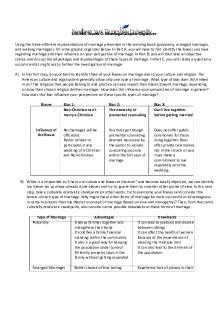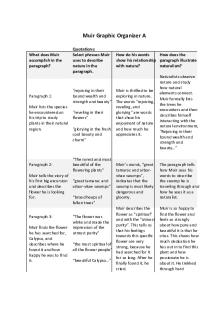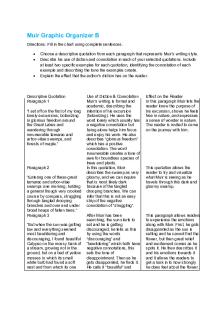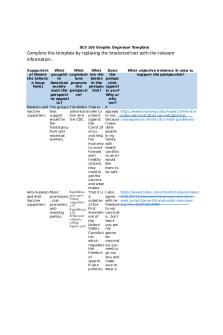Graphic Organizer on Marriage PDF

| Title | Graphic Organizer on Marriage |
|---|---|
| Author | Keith Oliver |
| Course | Perspectives in the Social Sciences |
| Institution | Southern New Hampshire University |
| Pages | 2 |
| File Size | 103.9 KB |
| File Type | |
| Total Downloads | 80 |
| Total Views | 177 |
Summary
Download Graphic Organizer on Marriage PDF
Description
SCS 100 Theme 2: Marriage Graphic Organizer Using the three different representations of marriage presented in the learning block (polyandry, arranged marriages, and walking marriages), fill in the graphic organizer below. In Part A, you will have to first identify the biases you have regarding marriage and their influence on your perspective of marriage. In Part B, you will then take an objective stance and discuss the advantages and disadvantages of these types of marriage. In Part C, you will create a question a social scientist might ask to further the investigation of marriage. A) In this first step, do your best to identify three of your biases on marriage due to your culture and religion. The American culture and legal system generally allow only one type of marriage. What type of bias does this embed in us? The religions that people belong to and practice can also impact their biases toward marriage, depending on how their chosen religion defines marriage. How does this influence your perspective of marriage in general? How does this bias influence your perspective on these specific types of marriage? Biases
Influence of the Biases
Bias 1: Non-Christian can’t marry a Christian
Bias 2: The necessity of premarital counseling
Bias 3: Can’t live together before getting married
No marriages will be officiated. Pastor refuses to participate in any wedding of a Christian and Non-Christian
You must go through premarital counseling deemed necessary by the pastor to include counseling sessions within the first year of marriage
Does not offer public ceremonies for those living together. Does offer private ceremonies not in the church or you must make a commitment to live separately until the wedding.
B) While it is impossible to “check our culture and biases at the door” and become totally objective, we can identify our biases (as you have already done above) and try to ignore them to consider other points of view. In this next step, take a culturally relativistic standpoint (in other words, try to overcome your biases) and consider the tenets of each type of marriage. Why might these other forms of marriage be more successful or advantageous in certain contexts than the Western concept of marriage (based on love and monogamy)? Then, from that same culturally relativistic standpoint, also consider some possible drawbacks to these forms of marriage. Type of Marriage Polyandry
Advantages It keeps families together and strengthens their bond It solidifies a family financial standing within the community It also is a good way for keeping the population under control All family property stays in the family without getting separated
Drawbacks It can lead to jealousy and divorce between siblings It can affect the health of women because of the dependence of pleasing the multiple men It can also lead to the diminish of the population
Arranged Marriages
Better chance of love lasting
Experience lack of privacy in their
Walking Marriages
Expectations are established from the very beginning. The families of both are greatly involved ensuring that the bride and the groom equally matched socially and financially.
relationships due to closeness of family and relatives interfering. Family feuds Rejection of female Jealousy by family members that could lead to the breakup of the couple.
Generally, live in large extended families, with many generations. Family structure is stable. There is no preference for one gender over the other in children. Divorce is a non-issue. Property is never shared. Family share in the duties of supporting and raising the children.
The man, never lives with the woman. The father may have little or no responsibility for his children. In poorer populations there will be a strong preference for male children. Large extended families living within communal quarters, without private bedrooms or living areas.
C) Create a question: In this learning block, you were given a lot of information about marriage and what marriage means in different cultures. You were also asked to think about what marriage means to you. The next step is to take the information you have been given and create a question a social scientist might ask to further the investigation of marriage. For example, after reading about arranged marriages, you might ask: Are rates of depression higher in women in arranged marriages? Social scientists use existing information to come up with new questions. This is the iterative process of social science research. What type of marriage provides the a more stable foundation for family financially, socially and emotionally?...
Similar Free PDFs

Graphic Organizer on Marriage
- 2 Pages

Graphic Organizer
- 3 Pages

SCS 100 Graphic Organizer
- 1 Pages

Wordsworth Graphic Organizer A
- 2 Pages

Amanda Lang Graphic Organizer
- 4 Pages

Graphic Organizer Table
- 6 Pages

Muir Graphic Organizer A
- 2 Pages

Muir Graphic Organizer B
- 2 Pages

Spacecat Graphic Organizer
- 1 Pages
Popular Institutions
- Tinajero National High School - Annex
- Politeknik Caltex Riau
- Yokohama City University
- SGT University
- University of Al-Qadisiyah
- Divine Word College of Vigan
- Techniek College Rotterdam
- Universidade de Santiago
- Universiti Teknologi MARA Cawangan Johor Kampus Pasir Gudang
- Poltekkes Kemenkes Yogyakarta
- Baguio City National High School
- Colegio san marcos
- preparatoria uno
- Centro de Bachillerato Tecnológico Industrial y de Servicios No. 107
- Dalian Maritime University
- Quang Trung Secondary School
- Colegio Tecnológico en Informática
- Corporación Regional de Educación Superior
- Grupo CEDVA
- Dar Al Uloom University
- Centro de Estudios Preuniversitarios de la Universidad Nacional de Ingeniería
- 上智大学
- Aakash International School, Nuna Majara
- San Felipe Neri Catholic School
- Kang Chiao International School - New Taipei City
- Misamis Occidental National High School
- Institución Educativa Escuela Normal Juan Ladrilleros
- Kolehiyo ng Pantukan
- Batanes State College
- Instituto Continental
- Sekolah Menengah Kejuruan Kesehatan Kaltara (Tarakan)
- Colegio de La Inmaculada Concepcion - Cebu






